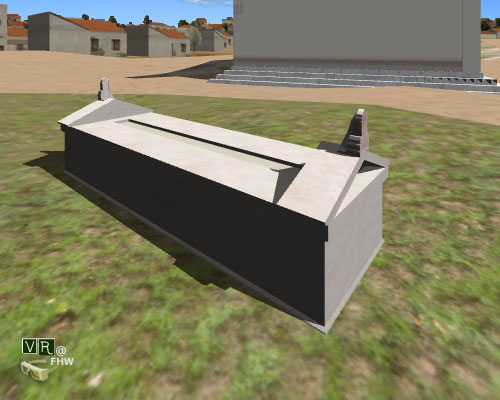Location: West of the Stoa Poikile, outside the main archaeological site of the Agora. No in the Agora plan
Date of construction: c.500 BC
Periods of Use: Archaic, Classical, Hellenistic, Roman
INTRODUCTION
The Altar of Aphrodite is the best preserved monument in the north side of the Agora. It was constructed in the 5th cent. BC, but remained in its place serving the adjacent temple dedicated to the same goddess, which flourished mainly during the Roman period. Most of the altar still survives.
CLASSICAL PERIOD
Description of the Monument
The Altar of Aphrodite Ourania, the best surviving monument of the north side of the Agora, was excavated by the American School of Classical Studies in 1981 and 1982.
The base of the monument and the southern half of the altar were unearthed in their original position. The base was oriented to the cardinal points, so that the priest could face due east. It measured 5.08 x 2.40m and was made up of hard red limestone. A series of hard limestone slabs create a crepidoma 0.27m in height, where the base rests. The core of the altar consists of soft blocks of yellow limestone, arranged at a distance of 0.22m from each other. The core was faced with orthostatai of white Cycladic marble, and three of these survive in situ. The bases of the orthostatai are decorated with a cyma. The total length of the altar was 4.42m, while its width measured 1.585m at the surviving south end (including the relief cyma). Two krateutai (parts of the altar’s pedimental crowning) decorated with akroteria comprising anthemia were discovered in the adjacent area (beneath a modern building, at a distance of 26m from the altar); in all likelihood these belong to this altar. When unearthed, one of the anthemia preserved traces of colour on its petals and the stems of its helices (Α 3774a: height 0.717m, width 0.80m, diameter 0.80m. The height of the akroterion is 0.362m. Α 3774b: height 0.723m, width 0.42m, diameter 0.20m. The height of the akroterion is 0.361m). Because the edge of one of the two krateutai bears signs of anathyrosis, it is thought that the akroterion comprised three slabs in total. Its base, according to the suggested representation, would correspond precisely to the width of one of the altar’s narrow sides. We should also note the similarity between the orthostatai and the krateutai, in terms of the excellent craftsmanship as well as in terms of the material empolyed (Cycladic marble).
The dating of the monument is based on the pottery unearthed inside the altar, which is dated to c.500 BC, but also on the use of Cycladic marble, which predates the widespread use of Pentelic marble (not before 490 BC). A construction date falling between 500-490 BC seems most likely.
The study of the osteological material gathered during the excavation suggests that sacrifices in honour of the goddess were offered here mainly during the springtime (pigs, doves, goats).
While the finds and the structure’s architectural form confirm its identification as an altar, we cannot be equally certain with respect to the divinity to which it was dedicated. It was identified as the Altar of Aphrodite Ourania, based on a reference to a temple of Aphrodite Ourania in Pausanias, still surviving in his time, which harboured a statue of the goddess, a work of Pheidias. This identification is reinforced by the presence of two reliefs in the site, undoubtedly depicting the figure of the goddess, but also by the discovery of the aforementioned faunal remains. The adjacent temple, however, has not been discovered, and, on the contrary, the altar is topographically related to a Late Roman building situated at its north. It is possible that the Classical temple is located in an unexcavated spot.
Around 480 BC, the surrounding area was elevated substantially, covering the original crepidoma. At a later stage the monument must have been damaged extensively, and this led to its reconstruction, at least of the upper section of the altar. Its reconstruction was based on the older design and the consequent filling of the surrounding area with debris, especially in the west part of the altar, took place in 430-420 BC. The ground level there rose by up to 0.35m with respect to the crepidoma.
Identification of the Monument
At some distance from the altar and the place previously considered as the site of the Temple of Aphrodite Ourania Pausanias describes, after his description of the Hephaesteion, a treasure was excavated with epigraphical evidence connecting it to the worship of this goddess. Thus, the identification suggested by the excavators is considered problematic. In the report of the American School for 2005, however, the director of the School mentioned that Aphrodite figurines were unearthed close to the altar, and this gives new credence to this identification.
BIBLIOGRAPHY
Mc CAMP II, J., Η Αρχαία Αγορά της Αθήνας. Οι Ανασκαφές στην καρδιά της κλασικής πόλης2 (Αθήνα 2004), pp. 78-79.
OSANNA, M., ‘Il problema topografico del santuario di Afrodite Urania ad Atene’, Annuario della Scuola Archeologica di Atene 66-67 (1988-1989), pp. 73-95.
REESE, D., ‘Faunal Remains from the Altar of Aphrodite Ourania, Athens’, Hesperia 58 (1989), pp. 63-70.
SHEAR, T.L., ‘The Athenian Agora: Excavations of 1980-1982’, Hesperia 53 (1984), pp. 1-57, plates 1-11.

Altar of Aphrodite Ourania, Representation in VR environment 
